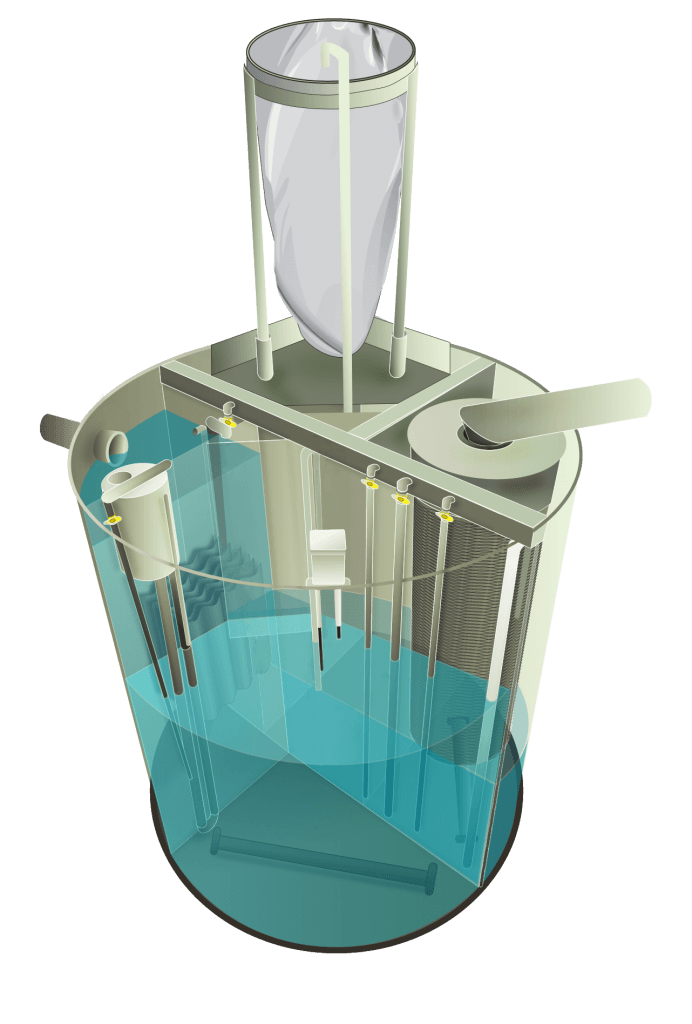
Monoblock wastewater treatment systems as an innovative method of wastewater treatment
Biological treatment facilities are used to treat wastewater from domestic pollution sources, which originate from small sources such as single-family houses or small multi-family buildings. These facilities are designed to process wastewater volumes ranging from 1.5 to 12 m3 per day.
If you have a house located outside densely populated areas and do not have access to a centralized sewerage system, domestic monoblock treatment plants will be an ideal solution. They are suitable for single-family houses in rural areas or vacation homes in the mountains.
In this process, bacteria play a crucial role, working in the presence of oxygen. They are capable of capturing and treating organic substances that are dissolved or present in high quantities in wastewater.
Monoblock wastewater treatment plants: advantages
In addition to all the obvious and well-known advantages that are inherent in domestic treatment facilities, such as saving on the household budget and contributing to environmental development, “BIOTAL” company offers several unique features that distinguish their treatment plants:
- protection against excessive sludge discharge;
- the biological treatment system has high efficiency;
- resilience to adverse environmental conditions;
- easy maintenance;
- long operational lifespan;
- reliable operation with minimal servicing.
Monoblock wastewater treatment plants – description process
The wastewater is first passed through a stainless steel screen, which is used to capture coarse contaminants. Then, it is directed to anoxic chambers where biological nitrogen removal and partial phosphorus removal occur. Mechanical treatment is also conducted in this stage to break down solid impurities.
Further transfer of the wastewater occurs by gravity to a space with a low load of activated sludge. Biological decomposition of organic pollutants and nitrification of ammonium nitrogen take place here. The aeration system is provided by an external reciprocating compressor that creates fine air bubbles.
An additional treatment stage involves separating the treated wastewater from the activated sludge. The treated wastewater is discharged into a watercourse, while the activated sludge from the bottom of the secondary settler is recirculated to the anaerobic section, maintaining the concentration of activated sludge at no more than 25%.
Installation features
The installation of BIOTAL systems has the following features: the cylindrical polypropylene bioreactor used for wastewater treatment is placed in an underground reinforced concrete well, at a distance of at least 5 meters from residential buildings. The control unit and air blowers can be located in an existing non-residential space with ventilation and heating systems or in a specially constructed blower room. The maximum distance between the blower room and the well with the BIOTAL system is 20 meters.
The monoblock BIOTAL units are available in the following types: MPD, MPD-R, MPD-RB, MPD-B, MPD-BU, MPD-RBU.
Please note!
The warranty period for BIOTAL systems is 5 years, for the control unit and air blowers it is 3 years, and for the pumping equipment, it is 2 years.
We recommend conducting service maintenance for monoblock BIOTAL units as follows: for private sector facilities (cottages, private houses, country estates, etc.) – once per quarter, and for other types of facilities (gas stations, cafes, hotels, manufacturing plants, etc.) – once per month.
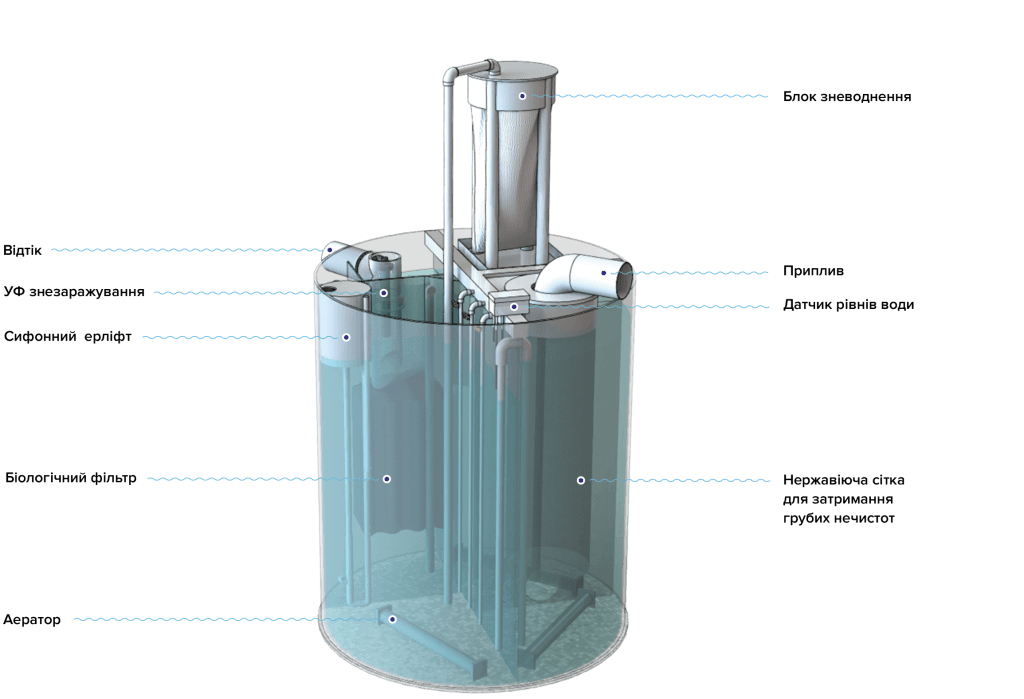
BIOTAL MPD
Monoblock units – BIOTAL wastewater treatment
Purpose
These are a special type of monoblock units designed for deep biological treatment of domestic wastewater with a volume ranging from 1.5 to 12 m3 per day. What makes these units unique is the presence of a dewatering block. This block ensures a high degree of compression and removal of excess moisture from the activated sludge. This allows for effective process control and provides economical and efficient wastewater treatment.
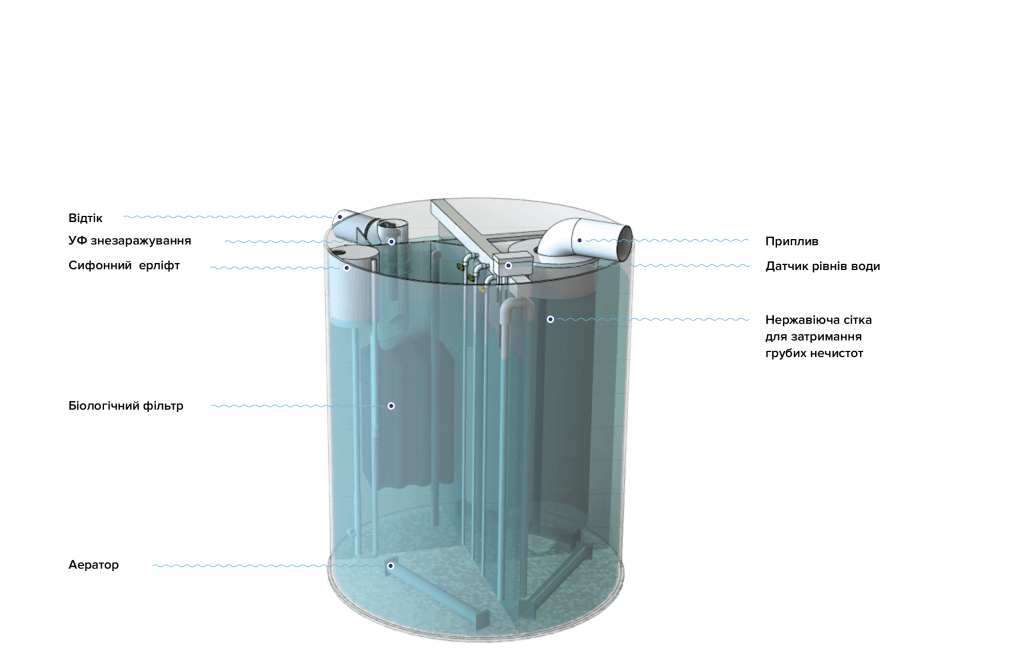
BIOTAL MPW
Monoblock units – BIOTAL wastewater treatment
Purpose
These are specialized monoblock units designed for deep treatment of domestic wastewater with a volume ranging from 2 to 12 m3 per day. They utilize a unique type of reactor made of polypropylene, which is housed in a circular reinforced concrete well. These units also feature a block for dewatering excess activated sludge to reduce its volume. This feature allows for effective wastewater treatment and efficient management of sludge treatment, making the process both effective and economical.
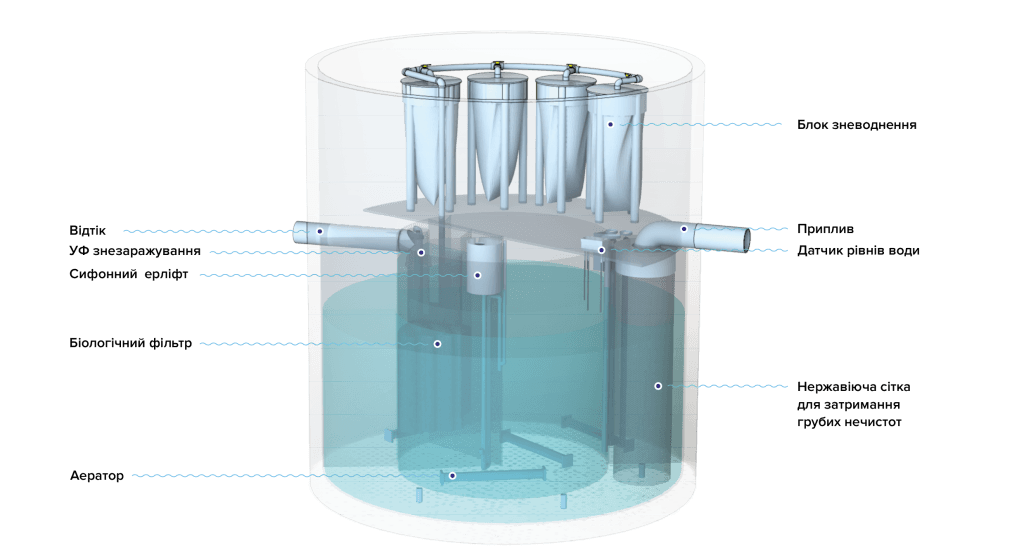
BIOTAL MCD
Monoblock units – BIOTAL wastewater treatment
Purpose
These are special monoblock units designed for deep treatment of domestic wastewater with a volume ranging from 2 to 12 m3 per day. They utilize a unique type of reactor made of polypropylene, which is housed in a circular reinforced concrete well. These units also feature a block that allows for dewatering excess activated sludge to reduce its volume. This feature enables effective wastewater treatment and efficient management of sludge treatment, making the process effective and economical.
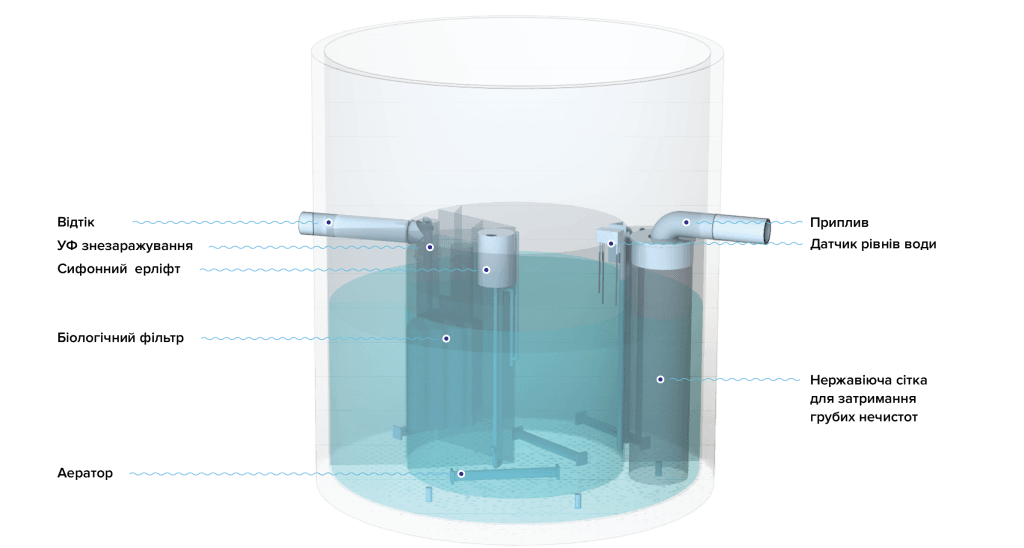
BIOTAL MCW
Monoblock units – BIOTAL wastewater treatment
Purpose
BIOTAL-MCW monoblock units are designed for deep treatment of domestic wastewater with a volume ranging from 2 to 12 m3 per day. They feature a special reactor made of polypropylene, housed in a circular reinforced concrete well. One of the key features of these units is the ability to pump excess sludge into a separate well, where it undergoes stabilization and compaction. This allows for effective wastewater treatment and optimal management of sludge, ensuring efficient operation of the treatment system.
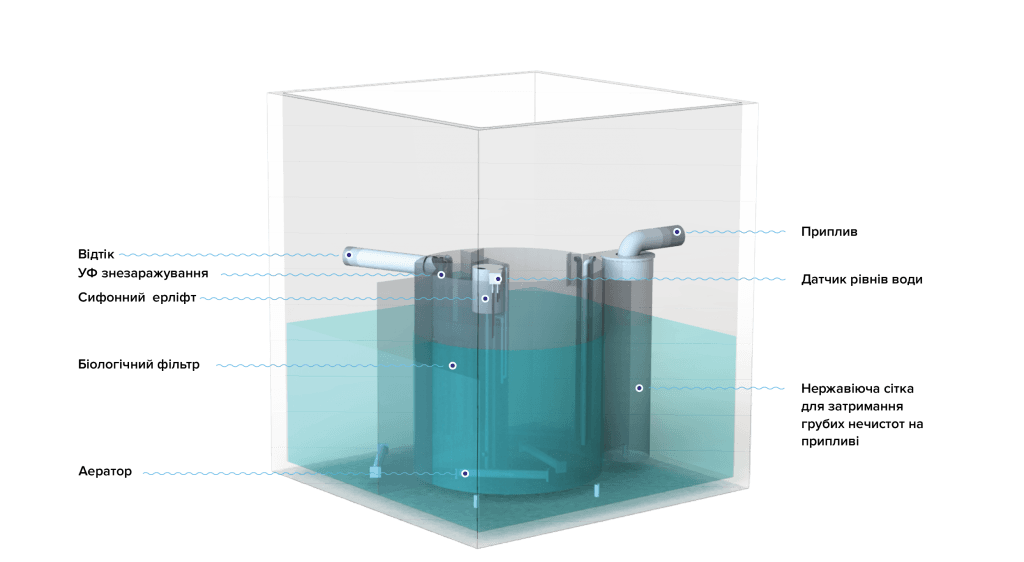
BIOTAL MSW
Monoblock units – BIOTAL wastewater treatment
Purpose
The monoblock units of the BIOTAL-MCW type are designed for deep treatment of domestic wastewater with a volume ranging from 2 to 12 m3 per day. They feature a special reactor made of polypropylene, which is located in a round reinforced concrete well. One of the key features of these units is the ability to pump excess sludge into a separate well, where it undergoes stabilization and compression. This enables effective wastewater treatment and optimal sludge management, ensuring the efficient operation of the treatment system.
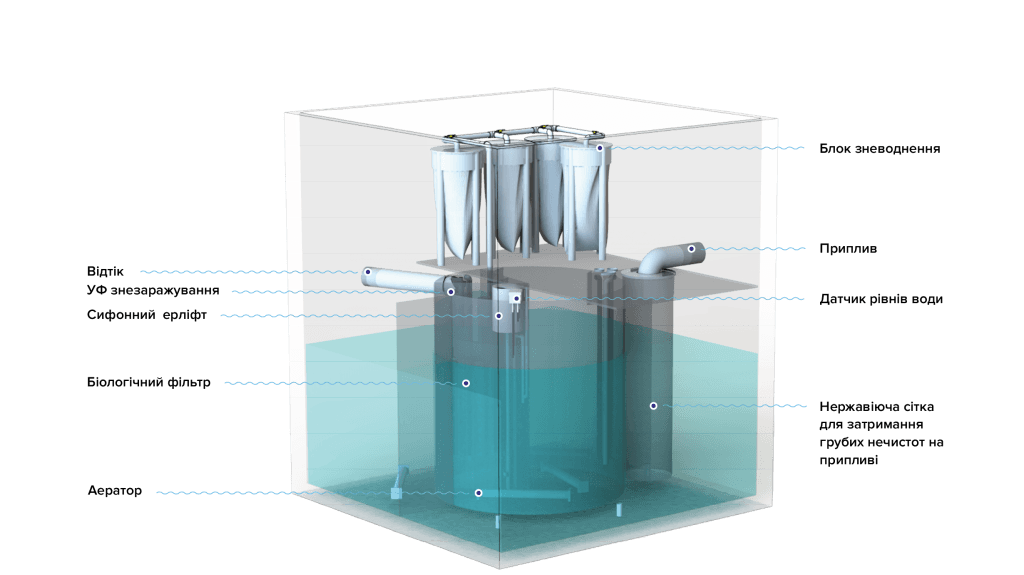
BIOTAL MSD
Monoblock units – BIOTAL wastewater treatment
Purpose
The monoblock units BIOTAL-MSD are designed for the treatment of domestic wastewater with a volume ranging from 2 to 12 m3 per day. They feature a special reactor made of polypropylene, located in a round well. The key feature of these units is the presence of a block for consolidation and removal of excess sludge. This helps to effectively purify the water and ensure optimal system operation.
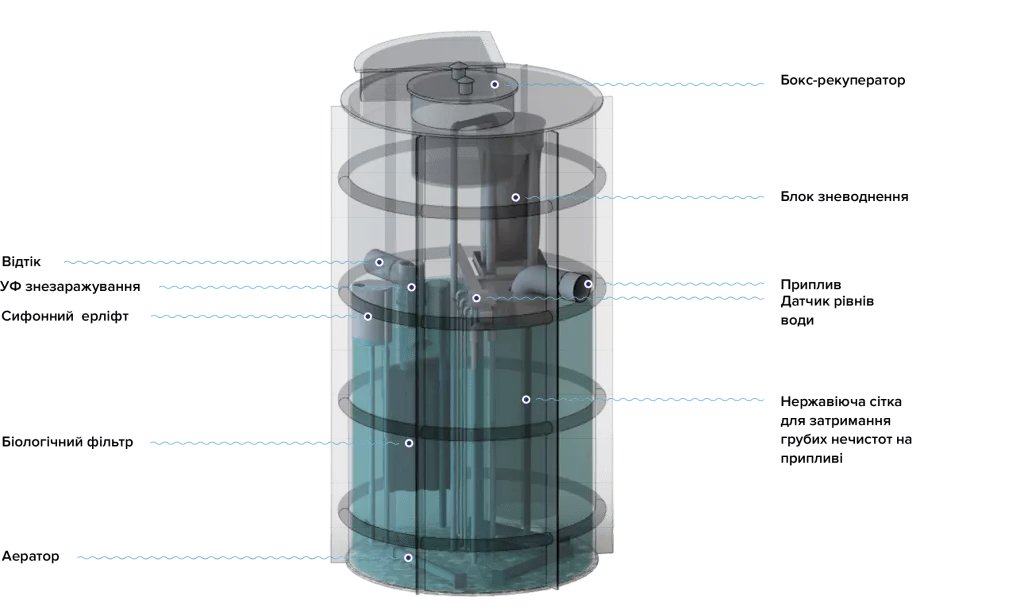
BIOTAL ERD
Monoblock units – BIOTAL wastewater treatment
Purpose
The high-strength monoblock units, BIOTAL, offer high productivity ranging from 1.5 to 12 m³ per day. They are designed for underground installation in dry soils, where the groundwater level does not exceed the bottom of the unit. The unit’s housing is robust and capable of withstanding underground installation without the need for reinforced concrete wells, thanks to its stiffening ribs. The unit is installed on a concrete foundation with layered backfill of sand and cement. A notable feature of these units is the dewatering block, which effectively consolidates and removes excess sludge.
Clarification of terms
- Dewatering block
A dewatering block is used to reduce the volume of excess activated sludge. - Stainless steel screen for coarse debris retention
Coarse debris is captured in the BIOTAL unit using a large stainless steel screen with dual-sided air scouring and a fixed cover. - Siphon airlift
A device designed to transfer treated wastewater to the biofilter-settler, which prevents the entry of surface pollutants into the subsequent treatment zone. - Biological filter
A self-cleaning biological filter that provides further treatment of wastewater and functions as a thin-layer settling tank. - Water level sensor
Designed to provide timely signals to the automation system of the unit, which automatically switches the system to one of the seven programs, resulting in up to 70% energy savings. - UV disinfection
The ultraviolet water disinfection unit is equipped with a UV-C lamp emitting at a wavelength of 254 nm. - Aerator
The aerator is made of PUR membrane with laser perforations, enabling fine bubble aeration of wastewater. This increases the oxygen saturation efficiency of wastewater and enhances the absorption properties of activated sludge bacte.
